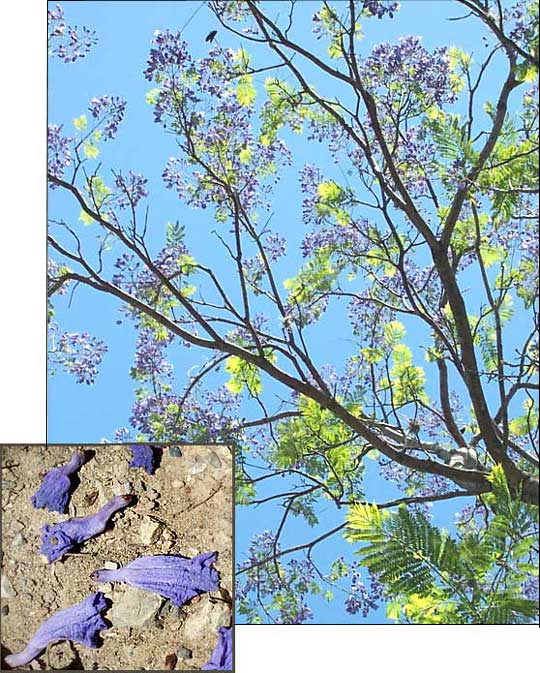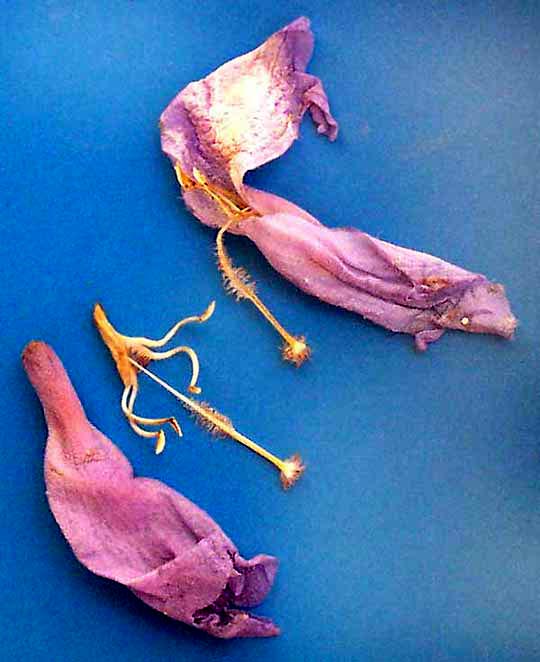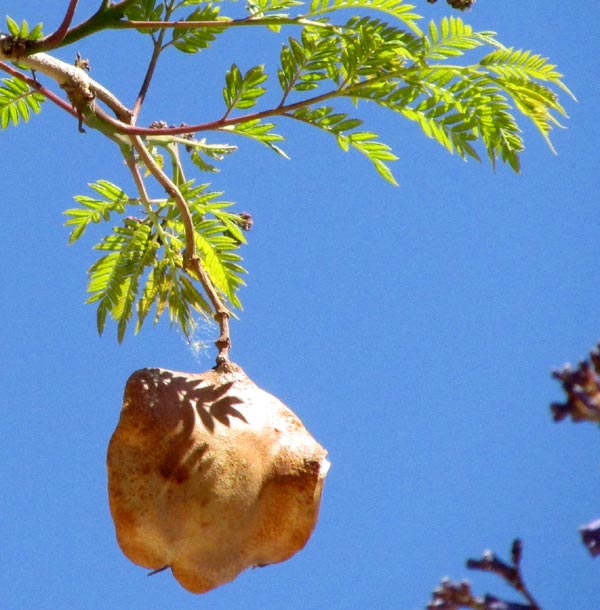Excerpts from Jim Conrad's
Naturalist Newsletter
from the April 14, 2007 Newsletter issued from Sierra Gorda Biosphere Reserve, QUERÉTARO, MÉXICO
JACARANDAS FLOWERING
For the last two or three weeks all across hot-weather Mexico in towns and along roads the Jacarandas have been blossoming into gigantic, lilac-colored bouquets. Even if you never look skyward the tree's blossoms are impossible to miss, for they strew the ground beneath trees with blue polka dots. I think the trees are most riveting when you stand beneath them looking up through their branches on dazzlingly sunny days such as we've had this week. Visualize translucent, purplish flowers against the deep blue sky, and freshly emerged, ferny leaves emerald green and wind- shaken, set among deliquescing, black-silhouette branches with sunlight-silvered edges. See this below:

The tree I'm referring to, growing up to 50 feet high, is JACARANDA MIMOSIFOLIA, in English often called Blue Jacaranda. It's a native of South America but planted worldwide in the tropics, even in southern Florida and places like Phoenix, Arizona. Besides being so pretty, jacarandas are popular because they can be grown easily from seeds or cuttings.
In size and shape Jacaranda's two-inch long, tubular flowers might remind Eastern North Americans of Catalpa or Trumpet-creeper blossoms. They should, because Jacaranda belongs to the same family as those plants, the Bignonia Family. Maybe half the species in that family are woody vines and the vast majority have opposite leaves. Jacarandas distinguish themselves in the family by being trees with twice-pinnately compound leaves, and having bluish flowers with five corolla lobes but only four fertile stamens.
The expected fifth stamen is reduced to a sterile, club- shaped "staminode" typically bearing a dense tuft of bristles. You can see this staminode, fuzzy at both its middle and its tip, on some dissected flowers, below:

In a 2016 pager by Josefa López Martínez and others, in a paper entitled "Does the Scrophularia staminode influence female and male functions during pollination?" I read that in our Blue Jacaranda the staminode's bristles are critically important in keeping small pollen-foraging bees closer to the stigma, resulting in more frequent contact and pollen transfer.
Nowadays in this area several things are flowering and fruiting, despite us still being in the dry season. I think the strategy of a good number of species is this: Have fruits mature at about the beginning of the rainy season, which arrives here next month, so seeds can germinate in well-watered soil.
entry dated April 30, 2022, issued from near Tequisquiapan, elevation about 1,900m (6200 ft), ~N20.57°, ~ W99.89°, Querétaro state, MÉXICO
JACARANDAS FRUITING

The Jacarandas are in full bloom now and already some of them are producing flattened, capsular-type fruits, as shown above. These capsules are are about 32-58mm long (1.2-2.8 inch) and 4-6cm wide (1.5-2.3 inch).